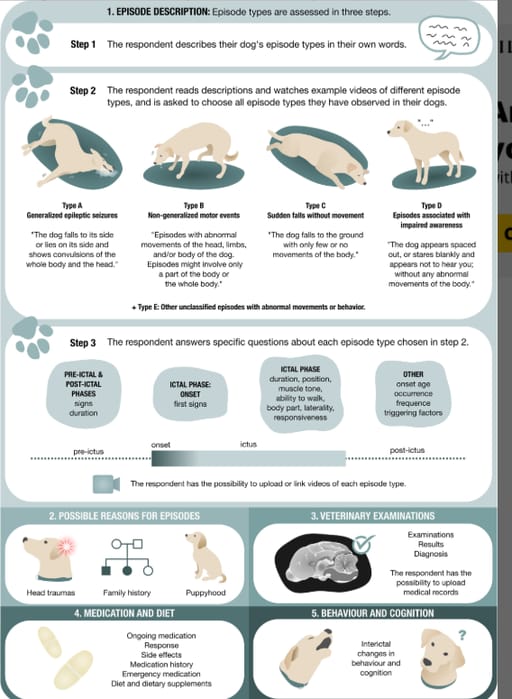- Veterinary View Box
- Posts
- Maybe we can make the difference...
Maybe we can make the difference...
J Vet Intern Med. 2025
Madlen S Matz 1, Tiina Harmas 2 3 4, Franziska Wielaender 1, Emma Hakanen 2 3 4, Jasmin N Nessler 5, Holger A Volk 5, Andrea Tipold 5, Paul J J Mandigers 6, Tarja S Jokinen 7, Luisa De Risio 8, Sally L Ricketts 9, Marjo K Hytönen 2 3 4, Thomas Parmentier 10 11, Fiona James 12, Sofie F M Bhatti 13, Gerhard Kluger 14 15, Hannes Lohi 2 3 4, Andrea Fischer 1
Background
Paroxysmal dyskinesia (PD) and idiopathic epilepsy (IE) are neurologic disorders reported in Border Terriers (BTs), but distinguishing between them clinically is challenging due to overlapping symptoms. There is no standardized method for large-scale phenotyping. This study aimed to develop and validate an online survey tool to facilitate widespread identification and classification of seizure and movement disorder phenotypes in BTs.
Methods
A web-based survey was constructed using clinical descriptors of IE and PD and distributed to BT owners in the UK. The survey included questions on episode frequency, duration, triggers, behavior during episodes, and video availability. Responses were categorized into IE, PD, or normal/control based on predefined diagnostic algorithms. Owner-submitted videos were independently reviewed to validate classifications.
Results
The survey collected 530 valid responses, with 119 dogs categorized as PD, 63 as IE, 39 as both IE and PD, and 309 as controls. The algorithm demonstrated strong concordance with veterinary diagnosis in reviewed cases. PD episodes were typically non-responsive, with dystonic movements and prolonged recovery. IE episodes were shorter, often generalized, and more likely to involve loss of consciousness. Video review supported survey-based phenotyping, though some misclassifications occurred due to overlapping features or vague descriptions.
Limitations
Reliance on owner-reported data introduces potential recall and misinterpretation bias. Not all cases were confirmed by a veterinarian, and diagnostic imaging or EEG was not available. The survey focused on UK-based BTs, limiting generalizability.
Conclusions
The survey is a reliable and scalable tool for differentiating IE and PD in Border Terriers and can support genetic and epidemiologic studies. It facilitates non-invasive, large-scale phenotyping, with video review enhancing classification accuracy. Broader validation and expansion to other breeds may further enhance its utility.

Structure of the epilepsy and dyskinesia questionnaire
How did we do? |
Disclaimer: The summary generated in this email was created by an AI large language model. Therefore errors may occur. Reading the article is the best way to understand the scholarly work. The figure presented here remains the property of the publisher or author and subject to the applicable copyright agreement. It is reproduced here as an educational work. If you have any questions or concerns about the work presented here, reply to this email.